Modified oil encapsulating proteins and uses thereof
a technology of modified oil and proteins, applied in the direction of polypeptides, polypeptides with his-tags, vegetable seeds, etc., can solve the problems of comparatively poor digestibility of leaves from c4 plants, insufficient oil production from a number of devoted seed crops, and other problems, to achieve the effect of raising the oil conten
- Summary
- Abstract
- Description
- Claims
- Application Information
AI Technical Summary
Benefits of technology
Problems solved by technology
Method used
Image
Examples
example 1
Creating Rabbit Anti-Sesame Seed Oleosin Antibodies
Generating Rabbit Anti-Sesame Seed Oleosin Antibodies
[0563]Full length sesame seed oleosin containing a C-terminal His tag (nucleotide sequence is shown in SEQ ID NO: 1) was expressed in E. coli and inclusion bodies were prepared by standard techniques. The inclusion bodies were solubilised in Binding Buffer (100 mM phosphate buffer pH 8.0, 500 mM NaCl, 8M urea and 10 mM imidazole) and loaded onto a column containing equilibrated ion metal affinity chromatography (IMAC) Ni agarose (Invitrogen). Non-bound proteins were removed from the column by washing with 6 volumes of Wash Buffer (100 mM phosphate buffer pH 8.0, 500 mM NaCl, 6M urea and 50 mM imidazole). Protein was eluted in 1 vol. aliquots of Elution Buffer (100 mM phosphate buffer pH 8.0, 500 mM NaCl, 6M urea and 250 mM imidazole). Eluted fractions were analysed by SDS-PAGE / Coomassie stain and the protein concentration measured using the Bradford's Assay. 265 μg of the IMAC-pur...
example 2
Design and E. Coli Expression of Modified Oleosins Containing One or More Artificially Introduced Cysteine Residue
[0565]Construct Design for Expression in E. coli
[0566]A number of modified oleosin constructs for expression in E. coli were designed. These contained either one or three cysteine residues on the N-terminal and C-terminal hydrophilic arms. The constructs were based on the nucleotide sequence and translated polypeptide sequence from a sesame seed oleosin, GenBank clone AF091840 which contains no cysteine residues (SEQ ID NO: 16).
[0567]All clones were subcloned into pET29b using engineered NdeI / XhoI sites. In addition, a ProTrp coding sequence was added to the coding region of the 3′ end of the C-terminal hydrophilic arm to mimic the amino acid residues encoded for by the NcoI site previously engineered by Peng et al (2006) Stability enhancement of native and artificial oil bodies by genipin crosslink. Taiwan Patent I 250466.
[0568]Oleosin-cysteine proteins mutated to incl...
example 3
Use of Anti-Sesame Seed Oleosin Antibodies to Bind Sesame Seed Oleosin with Artificially Introduced Cysteines
[0575]A dot-blot was used to compare the ability of the anti-sesame seed oleosin antibodies (Abs) described in Example 1 to bind to oleosin without cysteines versus the oleosins containing cysteines (described in Example 2). Dilution series from 12 to 0.25 ng of purified Ole-0-0, Ole-1-3 and Ole-3-1 were spotted onto a pre-equilibrated Hybond-P PVDF Transfer membrane. This was incubated with the anti-sesame seed oleosin antibodies at 1:2000 as the primary Ab. The blot was then incubated with the appropriate secondary Ab and developed by chemiluminescence (FIG. 7). The results indicate that on an immunoblot, the anti-sesame seed oleosin antibodies are up to an order of magnitude more sensitive to the oleosin without cysteine residues than the oleosins with cysteine residues. As a consequence of the different sensitivities it was necessary to load different quantities of recomb...
PUM
| Property | Measurement | Unit |
|---|---|---|
| Fraction | aaaaa | aaaaa |
| Efficiency | aaaaa | aaaaa |
| Hydrophilicity | aaaaa | aaaaa |
Abstract
Description
Claims
Application Information
 Login to View More
Login to View More - R&D
- Intellectual Property
- Life Sciences
- Materials
- Tech Scout
- Unparalleled Data Quality
- Higher Quality Content
- 60% Fewer Hallucinations
Browse by: Latest US Patents, China's latest patents, Technical Efficacy Thesaurus, Application Domain, Technology Topic, Popular Technical Reports.
© 2025 PatSnap. All rights reserved.Legal|Privacy policy|Modern Slavery Act Transparency Statement|Sitemap|About US| Contact US: help@patsnap.com



